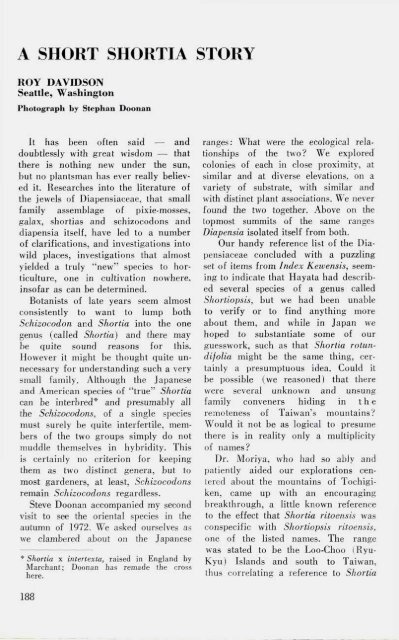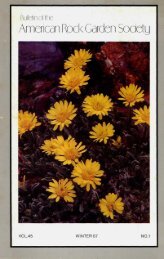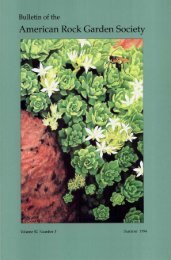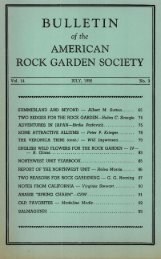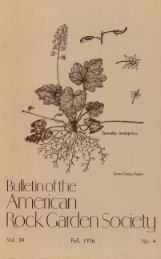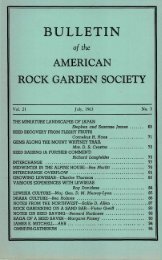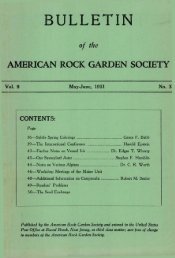Bulletin - Fall 1979 - North American Rock Garden Society
Bulletin - Fall 1979 - North American Rock Garden Society
Bulletin - Fall 1979 - North American Rock Garden Society
You also want an ePaper? Increase the reach of your titles
YUMPU automatically turns print PDFs into web optimized ePapers that Google loves.
A SHORT SHORTIA STORYROY DAVIDSONSeattle, WashingtonPhotograph by Stephan DoonanIt has been often said — anddoubtlessly with great wisdom — thatthere is nothing new under the sun,but no plantsman has ever really believedit. Researches into the literature ofthe jewels of Diapensiaceae, that smallfamily assemblage of pixie-mosses,galax, shortias and schizocodons anddiapensia itself, have led to a numberof clarifications, and investigations intowild places, investigations that almostyielded a truly "new" species to horticulture,one in cultivation nowhere,insofar as can be determined.Botanists of late years seem almostconsistently to want to lump bothSchizocodon and Shortia into the onegenus (called Shortia) and there maybe quite sound reasons for this.However it might be thought quite unnecessaryfor understanding such a verysmall family. Although the Japaneseand <strong>American</strong> species of "true" Shortiacan be interbred* and presumably allthe Schizocodons, of a single speciesmust surely be quite interfertile, membersof the two groups simply do notmuddle themselves in hybridity. Thisis certainly no criterion for keepingthem as two distinct genera, but tomost gardeners, at least, Schizocodonsremain Schizocodons regardless.Steve Doonan accompanied my secondvisit to see the oriental species in theautumn of 1972. We asked ourselves aswe clambered about on the Japanese* Shortia x intertexta, raised in England byMarchant; Doonan has remade the crosshere.ranges: What were the ecological relationshipsof the two? We exploredcolonies of each in close proximity, atsimilar and at diverse elevations, on avariety of substrate, with similar andwith distinct plant associations. We neverfound the two together. Above on thetopmost summits of the same rangesDiapensia isolated itself from both.Our handy reference list of the Diapensiaceaeconcluded with a puzzlingset of items from Index Kewensis, seemingto indicate that Hayata had describedseveral species of a genus calledShortiopsis, but we had been unableto verify or to find anything moreabout them, and while in Japan wehoped to substantiate some of ourguesswork, such as that Shortia rotundifoliamight be the same thing, certainlya presumptuous idea. Could itbe possible (we reasoned) that therewere several unknown and unsungfamily conveners hiding in theremoteness of Taiwan's mountains?Would it not be as logical to presumethere is in reality only a multiplicityof names?Dr. Moriya, who had so ably andpatiently aided our explorations centeredabout the mountains of Tochigiken,came up with an encouragingbreakthrough, a little known referenceto the effect that Shortia ritoensis wasconspecific with Shortiopsis ritoensis,one of the listed names. The rangewas stated to be the Loo-Choo (Ryu-Kyu) Islands and south to Taiwan,thus correlating a reference to Shortia188


